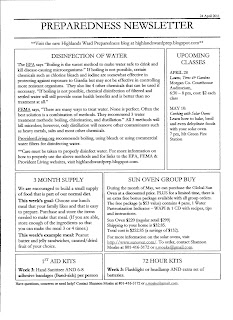I have provided links to several government websites that contain lots of information on flooding. You can find the links in the menu to the right. Scroll down until you see the category FLOODS. Click on the links under FLOODS to be directed to each website.
WHAT TO DO BEFORE A FLOOD:
Know how to monitor the hazard whether via radio or television.
Know what flood risks exist related to your location.
Consider purchasing flood insurance.
Consider options to protect your property
• Document personal property with photos or video.
• Store the documentation and valuable documents in a safe place away from your home.
• Install flood protection measures in and around your home.
Some measures recommended by ready.gov are:
Elevate the furnace, water heater & electric panel in your home if you live in an area that has a high flood risk.
Consider installing "check valves" to prevent flood water from backing up into the drains of your home.
If feasible, construct barriers to stop floodwater from entering the building and seal walls in basements with waterproofing compounds.
Find out how to keep food safe during and after and emergency by visiting www.FoodSafety.gov
Prepare a plan for your household:
• Be prepared to evacuate. Plan a safe retreat and for a place to meet in case you are separated.
• Choose an out-of-town contact to for everyone to call to let them know where you are.
• Prepare and maintain 72-hour kits for each family member.
• Prepare and maintain an emergency kit for your car.
• Get to know your neighbors and discuss how you can help each other.
• Plan how to take care of pets. Emergency shelters may not allow pets
Prepare to leave your home.
• If time allows, move valuables to highest inside part of your residence.
• If you can do so safely, turn off electricity, gas and water at main switches and valves.
• Know where the gas pilot lights are and how the heating/cooling system works.
WHAT TO DO DURING A FLOOD:
Be aware of streams, drainage channels, canyons and other areas known to flood suddenly.
If local authorities issue a flood watch, prepare to evacuate:
• Secure your home. If you have time, tie down or bring outdoor equipment and lawn furniture
inside. Move essential items to upper floors.
• If instructed, turn off utilities at the main switches or valves. Disconnect electrical appliances.
Do not touch electrical equipment if you are wet or standing in water.
• Fill the bathtub with water in case water becomes contaminated or unavailable. Before
filling, sterilize the tub with a diluted bleach solution.
Do not walk through moving water. Six inches of moving water can knock you off of your feet. If you must walk in a flooded area, walk where the water is not moving. Use a stick to check the firmness of the ground in front of you.
Do not drive into flooded areas. Six inches of water will reach the bottom of most passenger cars causing loss of control and possible stalling. A foot of water will float many vehicles. Two feet of water will wash away almost all vehicles. If floodwaters rise around your car, abandon the car and move to higher ground, if you can do so safely.
WHAT TO DO AFTER A FLOOD:
Avoid floodwaters and moving water. The water may be contaminated by oil, gasoline or raw sewage. The water may also be electrically charged from underground or downed power lines.
Be aware where floodwaters have receded. Roads may have weakened and could collapse under the weight of a car.
Stay away from downed power lines and report them to the power company.
Stay away from designated disaster areas unless authorities ask for volunteers.
Return home only when authorities indicate it is safe. Stay out of buildings if surrounded by floodwaters. Use extreme caution when entering buildings. There may be hidden damage, particularly in foundations.
Consider your families health and safety needs:
• Wash hands frequently with soap and water if you come in contact with floodwaters.
• Throw away food that has come in contact with floodwaters.
• Listen for news reports to learn if the water supply is safe to drink.
• Listen to news reports for information about assistance for housing, food and clothes.
• Seek necessary medical care at the nearest medical facility.
Damaged Sewage systems are serious hazards.
Service damaged septic tanks, cesspools, pits, and leaching systems as soon as possible.
Contact your insurance agent.
• Take photos or videos of the damage.
• Separate damaged and undamaged items.
• Locate your financial records.
• Keep detailed records of cleanup costs.
Information from bereadyutah.gov and ready.gov.



